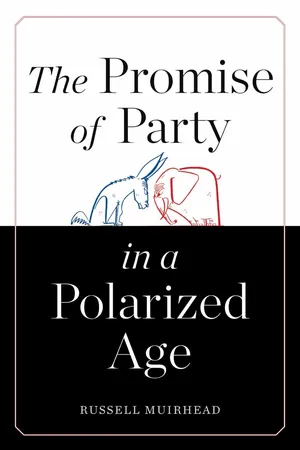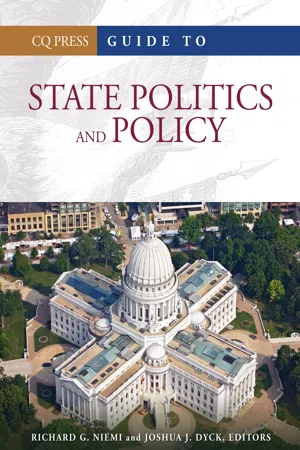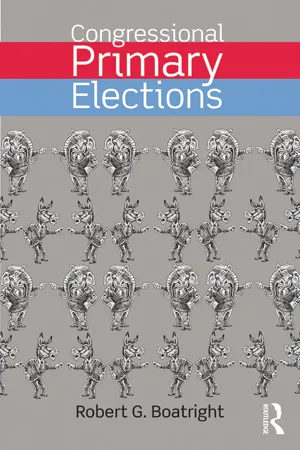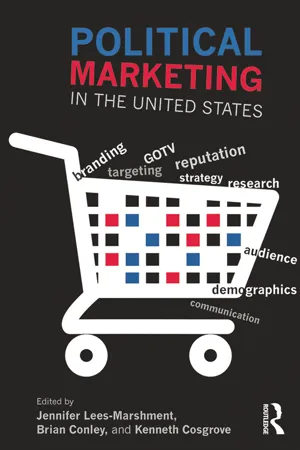Politics & International Relations
Blanket Primary
A blanket primary is a type of primary election in which voters can choose candidates from any political party. This means that voters are not required to be registered with a specific party to participate in the primary. The top vote-getters from each party then advance to the general election.
Written by Perlego with AI-assistance
Related key terms
6 Key excerpts on "Blanket Primary"
- eBook - ePub
- Russell Muirhead(Author)
- 2014(Publication Date)
- Harvard University Press(Publisher)
The reform of the reform aims to succeed at what primary elections have tried to do from the start: get ordinary citizens to participate in the selection of nominees. The more specific aim is to moderate American politics by selecting for less ideological nominees. The current impulse is to strip primaries of their partisan aspect by forcing candidates in primaries to face a broader sample of the electorate. Voters in California attempted to do this in 1998, when they passed a referendum to institute a Blanket Primary. Any voter could vote for any candidate from any party in every office. The top vote-getter within each party would advance to the general election. Unlike the classic closed primary, a Blanket Primary is not restricted to voters who register with a party; a voter might vote for the Republican candidate for Congress and the Democratic candidate for governor, and so on. The task of the primary voter in this case is not to participate in a party contest, and thus to think like a narrow partisan; it is to pick out the best person from among all parties for each job.The California reform was halted by the U.S. Supreme Court, which in California Democratic Party v. Jones struck down the Blanket Primary in 2000.32 In the Court’s view, California’s Blanket Primary violated the right of association by canceling a party’s ability to nominate candidates. The Court was motivated by the following kind of scenario: Consider an election where two Green Party candidates run against each other in the primary (and, of course, against a bevy of candidates from competing parties). The losing Green Party candidate might get more votes from registered Green Party members than the winning one—in which case the Green Party loses the ability to nominate its members and has been hijacked by voters who have no affiliation with the party.In a state where one party dominates, as the Democratic Party does in Massachusetts or the Republican Party does in Utah, it is quite possible that voters who sympathize with the minority party will vote for a candidate of the dominant party in order to have more influence. If the Blanket Primary were used in a state like Massachusetts, and two liberals were to split the vote of Democratic partisans, it would be possible for independents and Republican voters to vote for a more conservative third Democrat, even if this third candidate gets fewer votes from Democratic partisans than the two liberal candidates. Voters who are registered Democrats would lose control over which candidate gets to run in the general election as a Democrat. The Court worried that in a case like this the Democratic Party would no longer be associated with the goals, policies, and principles that voters who identify with the party would give it. Voters, in the Court’s view, lose the freedom to associate as partisans. - eBook - ePub
- Richard G. Niemi, Joshua J. Dyck(Authors)
- 2013(Publication Date)
- CQ Press(Publisher)
23FROM Blanket Primary TO TOP-TWO PRIMARYThe Blanket Primary, first instituted in Washington State in 1935, provides voters with a ballot listing all potential nominees, regardless of party affiliation. Voters are allowed to select one candidate for each office, and the highest vote-getter from each party receives its nomination. Promoted by the Washington State Grange, a nonpartisan good-government organization, it was intended to give independent voters a voice in nominations, to prevent a return to machine-style politics, and to promote the selection of moderate candidates.Blanket primaries were controversial. Opponents argued that they eliminated a party organization’s right to define its members and control participation in its internal affairs, including selecting its nominees. In California Democratic Party v. Jones (2000),1 the U.S. Supreme Court ruled that blanket primaries were unconstitutional because they restrict the party organization’s freedom of association as protected by the First Amendment.In the aftermath of the Court’s decision, California, Nebraska, and Washington modified their Blanket Primary procedures by adopting the so-called top-two primary (also referred to as the nonpartisan primary or the jungle primary). Rather than resulting in the selection of one Republican and one Democratic nominee for each office, top-two primaries reserve a place on the general election ballot for the top-two vote-getters, regardless of their party affiliations. Louisiana has used a similar system since 1975, with one modification: if a primary candidate receives more than 50 percent of the vote, he or she is sworn into office, and no general election is held for that position. The top-two primary is unique because voters can select two nominees from the same party to compete in the general election. During the 2012 primary in California’s 31st district, Pete Aguilar, a Democratic U.S. House candidate and a favorite of the Democratic Congressional Campaign Committee, failed to win enough votes to advance to the general election. This resulted in two Republican candidates, Gary Miller and California state senator Bob Dutton, competing against each other in the November election. - eBook - ePub
Law and Election Politics
The Rules of the Game
- Matthew J. Streb(Author)
- 2013(Publication Date)
- Routledge(Publisher)
period . Whoever finished first and second in a single, overall vote count would go on to the general election, regardless of party affiliation.Running in one's party's primary election is the first step toward winning elective office in most states in the United States. Evidence from scholars who have studied the issue supports the plaintiffs' claims that primaries do affect the outcomes of elections, and they often do so in very dramatic ways. Primary electoral rules can help determine the winners and losers of elections. We should not be surprised, then, that disputes over primary laws often, as was the case in Washington and in California, end up in courts of law. In this chapter, we detail how primaries work, describe the most common types of primaries in the United States and discuss how the type of primary used affects electoral outcomes. We then explain relevant case law regarding primaries, focusing on how courts must answer the question “What is a party?” to resolve cases involving primary election law.What is a Primary?Simply put, a primary is the means by which parties select candidates for the general election. According to Article 1, Section 4 of the United States Constitution, states are responsible for passing laws governing the “times, places, and manner” of holding all elections for federal offices. This rule also applies to primary elections, which began being held in the early part of the twentieth century as part of a tide of Progressive reforms (Key, 1956). States can determine when primary elections will be held, whose name can go on a primary ballot (most states have signature requirements or filing fees or both), and who is allowed to vote in a primary. As may be expected, states vary a good deal on the rules they have implemented to govern how primary elections work. - eBook - ePub
- Robert G. Boatright(Author)
- 2014(Publication Date)
- Routledge(Publisher)
There was little crossover voting. Congressional primaries were actually less competitive than is the norm in California, voter turnout was down, and candidate spending remained similar to what it had been in 1996 (Tam Cho and Gaines 2002). There was little evidence that the Blanket Primary affected the fortunes of moderates, racial minorities, or women, although one study contended that it might have aided Latino Republicans (Gerber 2001, 2002; Caul and Tate 2002; Segura and Woods 2002). A study of the election conducted several years later argued that the Blanket Primary aided moderate candidates running in competitive districts, but the authors cautioned that this finding was more robust for state legislative races (because there were more of them) than for congressional races (Bullock and Clinton 2011). Perhaps most consequentially, most voters said when asked that they approved of the Blanket Primary, but the Blanket Primary appears not to have changed their feelings of political efficacy or approval of elected politicians (Gerber 2001). 12 The consensus among researchers, then, was that the Blanket Primary did not live up to the predictions of either its supporters or its opponents. Perhaps this was a consequence of the dynamics of 1998, and perhaps politicians would have adjusted their behavior as they grew accustomed to campaigning in blanket primaries (Petrocik 2002). California’s experience with cross-filing suggests that incumbents might have changed the way they campaign, using their position in office to reach out to voters of the other party - eBook - ePub
Promise and Challenge of Party Primary Elections
A Comparative Perspective
- William P. Cross, Ofer Kenig, Scott Pruysers, Gideon Rahat(Authors)
- 2016(Publication Date)
- McGill-Queen's University Press(Publisher)
referred to these as “direct votes” (Cross 1996). A year later, a different article in the same journal referred to the Alberta Conservatives’ membership ballot as a “premier primary” (Stewart 1997). Other terms that have been used in academic work include “membershipballots ” (Carty and Blake 1999; Quinn 2010) and “one-member-one-vote systems ”(Courtney 1995, 233). In other words, both journalistic and academic works have given a variety of names to similar processes. It is therefore important to determine a common definition of primaries – that is, to establish an umbrella term for these similar, yet not identical, processes.The challenge for this chapter is to propose a useful conceptual framework to decide which methods of intra-party elections should be regarded as primaries and which should not.As we will see, the term “primary” refers to a broad set of intra-party selection methods. In this regard, the methods found in the primary umbrella are analogous to the study of electoral systems. The most common and accepted way to study electoral systems is to group them into different categories, often referred to as “families” (Farrell 2011). Three broad families can be identified:plurality/majority , proportional, and mixed (Reynolds, Reily, and Ellis 2008). The defining characteristic for this categorization is typically the degree of proportionality.Despite grouping them together under a common label, there are often significant differences between electoral systems in the same family. Take, for example, the group of electoral systems that fall under the umbrella of proportional representation (PR ). This family of electoral systems includes those ranging from panachage , to open and closed list PR , to the single transferable vote (STV ). Some countries, such as Israel, use a single countrywide district while others, for example Argentina and Portugal, have a number of smaller districts (usually along the lines of sub-national units). Likewise, STV asks voters to rank candidates in order of preference, while closed list PR - eBook - ePub
- Jennifer Lees-Marshment, Brian Conley, Kenneth Cosgrove(Authors)
- 2014(Publication Date)
- Routledge(Publisher)
In summary, the literature suggests that primaries raise theoretical challenges around the nature of voter preferences and market focus. Furthermore, primaries create strategic challenges and employment opportunities for political marketers. Primaries matter.Theoretical Framework
What Preferences to Serve?In many ways the primary process is a wonderful expression of democracy. Party grandees cannot anoint the nominee in smoke-filled rooms. Primaries expand democracy, extending voter input from choosing between candidates to selecting the competing candidates. Primaries also bring challenges for political marketing theory.US political parties have a loose structure (Knuckey 2010). Ordinary voters, rather than paid-up party members, identify as Republican or Democrat and choose candidates. A large number of loosely associated voters give primaries surface commonalities with presidential elections, i.e., mass enfranchisement of the relatively uninvolved. One critical difference from a general election is the complexity of the voter’s decision. Primary elections select candidates for a future election; voters are therefore advised to consider the future electorate’s anticipated preference. This predicted appeal to the wider electorate is a candidate’s electability. Candidates must not only appeal to primary voters but also must reassure the primary voters that they can appeal to general election voters. Similarly, in primaries with three or more candidates, voters should consider whether a candidate is viable, i.e., can win the nomination. Most primaries feature numerous candidates, at least initially, so viability matters. Consider a Democrat in 2004 who preferred Joe Lieberman, or a Republican who favored Jon Huntsman in 2012. A voter might conclude that these candidates were not viable and so support his or her second-favored candidate. Voters strategically prefer a viable second-best candidate over their ideal candidate whom few others favor.
Learn about this page
Index pages curate the most relevant extracts from our library of academic textbooks. They’ve been created using an in-house natural language model (NLM), each adding context and meaning to key research topics.





